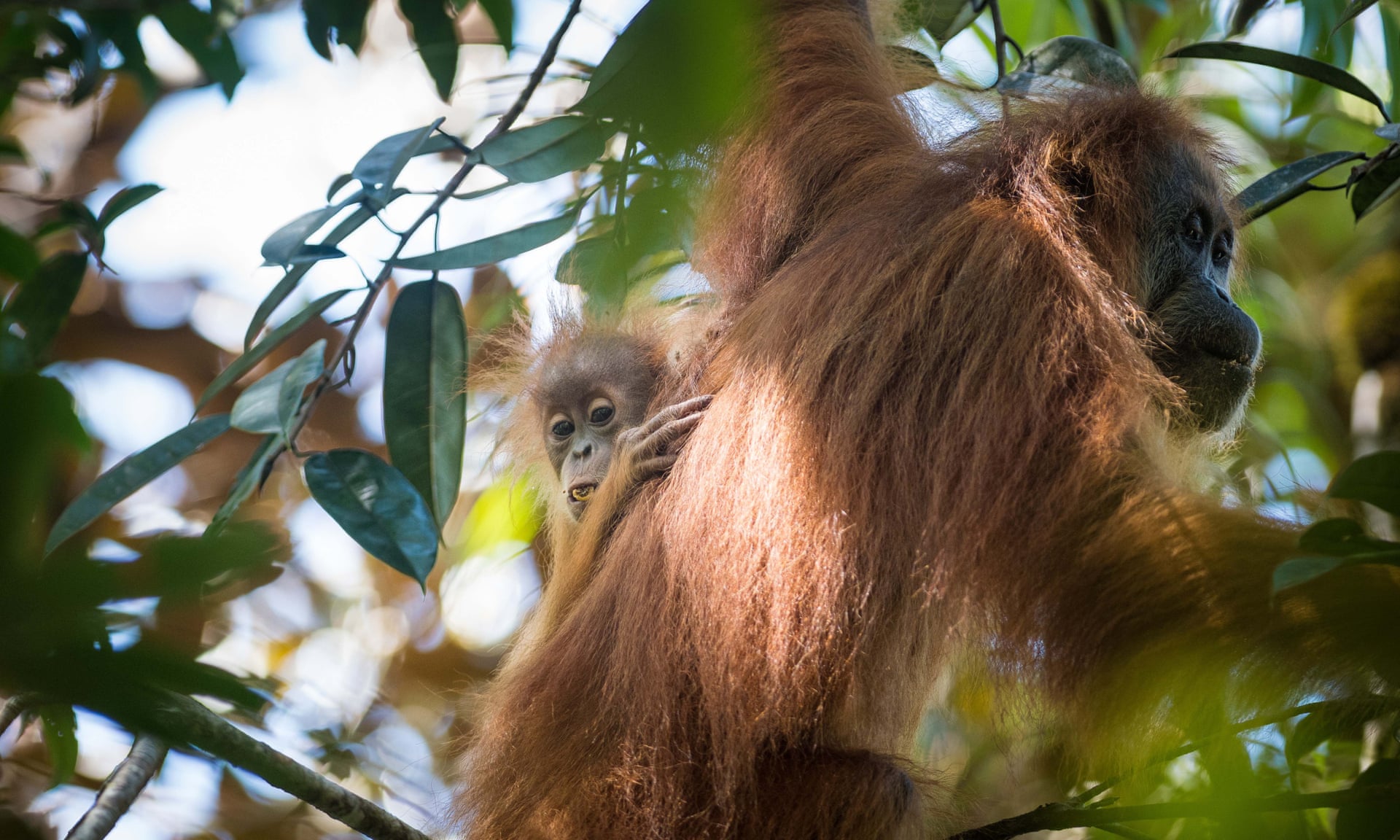 |
| A female Tapanuli orangutan with young |
A study of a small orangutan population in northern Sumatra has revealed a new species: the Tapanuli orangutan. The name derives from an area covered by the Batang Toru ecosystem located south of Lake Toba in northern Sumatra, where the orangutans are found. However, this discovery is nothing new. These apes were first reported in the early 1930s, but it was not until 1997 that scientists rediscovered them and later started studying the animals. An international team of researchers, in the journal Current Biology, described a wide-range of characteristics indicating that the Tapanuli orangutan is a distinct species. As part of the investigation, the team reported how they examined the remains of an adult male orangutan killed by villagers in November 2013. The analysis consisted of comparison of the skull and jaws to those of 33 other adult male orangutans, held in collections of ten institutions around the world, revealing that the skull of the male Tapanuli orangutan is smaller than those of Bornean and Sumatran orangutans. The researchers also noted the difference in the booming call of male Tapanuli orangutans to those of the two known species. In addition, they also indicated that Tapanuli orangutans have more cinnamon-colored pelts than Bornean orangutans with a curlier texture than the loose locks of Sumatran orangutans. The team also noted the facial hair of Tapanuli orangutans, indicating that dominant males have prominent mustaches and females have beards.
 |
| Male Tapanuli orangutan |
The researchers also conducted an analysis of the genomes of 37 orangutans from Borneo and Sumatra, enabling them to unpick the apes' evolutionary "family tree." The results implied that orangutans north of Lake Toba separated about 3.4 million years ago from the more southerly population of ancestral orangutans that first came from mainland Asia, giving rise to the Sumatran orangutans. A further separation from the population south of Lake Toba occurred about 674,000 years ago, giving rise to the Bornean species as well as the Tapanuli species that, like its ancestors, live south of Lake Toba. A previous research discovered that the mitochondrial DNA of Tapanuli orangutans is more similar to that of Bornean orangutans, while the nuclear DNA of the Tapanuli species is more similar to that of the Sumatran species. The new study disclosed that even after the separation between orangutans north and south of Lake Toba, the animals continued to interbreed which was possibly due to wandering males and resulted in mixing of the nuclear DNA. Fortunately, this behavior was cut short about 100,000 years ago - close to when a volcano erupted at Lake Toba - and stopped altogether between 20,000 and 10,000 years ago. Essentially, since the females stayed put, so too did the mitochondrial DNA. According to William Amos, professor of evolutionary genetics at the University of Cambridge, it was difficult to be precise when it came to timings of separations but that the proof for a new species stacked up. University of York's Dr. Andrew Marshall stated that the study emphasized the importance of conservation and added that there might also be an additional great ape species to be discovered. However, University College London's Professor Volker Sommer was not amazed, pointing out that there is no clear proof for what makes a new species. In his own words, he said that any bunch of expert biologists"can invent a new species, if they get their arguments together."
.jpg/1920px-Indonesia_-_Lake_Toba_(26224127503).jpg) |
| Lake Toba |
It is very amazing through scientific research that new species are being discovered, especially in places like Indonesia which is one the major biodiversity hotspots in the world. Earlier, much of the newly discovered species in Indonesia came in the form of small animals such as frogs, invertebrates, and probably birds. But this is the first time that a new species of orangutan has been discovered. The research team that studied this unique species noted a number of differences and similarities between the Tapanuli orangutan and the Bornean and Sumatran species from the morphological scale to the genetic scale. While there is a great deal of amazement from scholars in biological, evolutionary, and zoological fields, others like Professor Volker Sommer are more skeptical than amazed. They argue that there is no clear criteria for what makes a new species. Regardless, the Tapanuli orangutan is critically endangered like its Sumatran and Bornean counterparts with fewer than 800 individuals believed to be existing in an area covered by the Batang Toru ecosystem. Therefore, it requires a great deal of protection from habitat destruction and the illegal wildlife trade so that researchers can continue to study it to unlock any further secrets about this newly discovered species in the name of science.
View article and video here
No comments:
Post a Comment